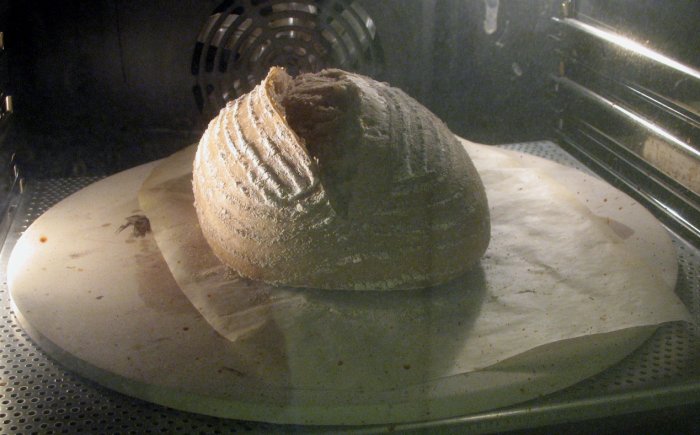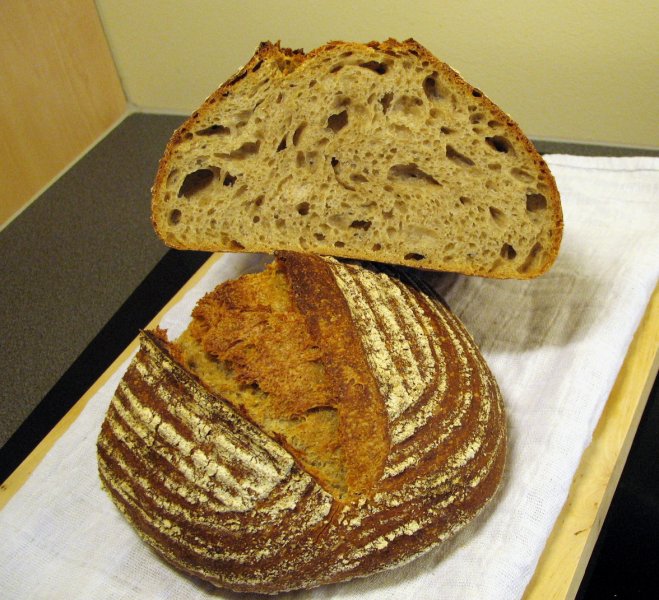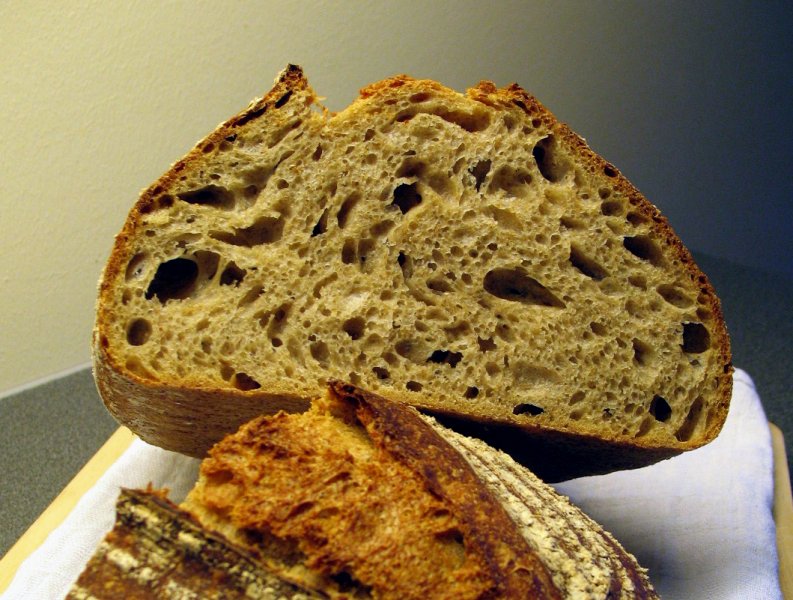
Pain au levain with whole wheat
Jacques Brel is alive and well and living in Paris.
I consider myself a mostly whole grain kind of person, but occasionally I get this insatiable hunger for lighter loaves. Perhaps it's a seasonable thing - fish, salads, shrimps, cold wine and white loaves in July; Sauerkraut, Bratwurst, aquavit and Roggenbrot in January. Anyways, I've baked mostly rye-centric things the last few weeks, so I wanted to mix it up a little. The thought of a very simple, clean loaf appealed to me - allow the flour and sourdough to take center stage. I browsed the chapter on levain breads in Hamelman's book, and was immediately tempted by the formula for pain au levain with whole wheat. I made it once before, but it never struck me as mindblowing at the time. Hmm. What could I've been thinking? Must've been busy with other stuff. Less important stuff than taking in the intoxicating aroma of this loaf, obviously.
Since Hamelman's formulas are bulletproof, I tried the best I could to follow this one to the letter. The only thing I did differently, was to mix the levain at 50% hydration instead of 60%. I keep my firm starter at 50%, a level that my little trooper finds comfy, so I added the remaining water to the final dough instead to get the overall figure right. The formula really is an excellent exercise in how to develop the dough with a minimal amount of mixing - the effects of autolyse and folds are very clearly illuminated.
I've read comments around here about difficulties incorporating firm levains in the final dough. I've never had any issues with this, as my levain is soft and sticky (like you wouldn't believe) when it's fully ripe. After a 30 min. autolyse, salt is sprinkled over the dough, and then I slather spoon-sized bits of ripe levain on top. It doesn't take more than a few seconds of first speed mixing to get everything completely incorporated afterwards. I mixed the dough on 2nd speed for about 90 seconds, and by that time it was coming away from the sides of the bowl and it looked all set. Miracles of autolyse and insights of Prof. Calvel. Then, two folds spaced by 50 mins. each (performed while watching a movie last night), before shaping and retarding overnight.
I pulled the loaf from the fridge this morning as the baking stone was heating up. I'm not sure why, but as long as the dough is not bordering on overproofing, I like to give it some time to warm up. Probably just me being superstitious, but I like the idea of waking up the yeast gradually before *pouff* - ***hot stone***. Here's the loaf in the oven, just after the cut started to open up and the crust started to colour:

And here's the loaf after a 45 min bake:

Here's a shot of the crumb:

And a close-up for the crumb-obsessed:

This loaf really blew my mind, I was so excited when I saw how nicely it rose in the oven and how the slash opened up. Also, keep in mind that this dough isn't sticky at all. The overall hydration is only 68%, and considering that there's 25% whole flour in there, it's very comfortable to work with. I think it goes to show that it's possible to achieve an aerated crumb without going all overboard with the water. I also think that the firmness of the levain contributed a lot to the profile of the loaf. As Dan and others have pointed out, a liquid starter or a poolish makes the dough more extensible. With European flours probably being weaker than American ones (I can't really be sure before I've tried, though...), I'm definitely going to keep my starter on the firm side. That way I can get a nicely developed dough just by autolyse and two folds, as in this formula.
I bet most of you Hamelman fans have tried this one already, but if you haven't, I'm recommending it from the bottom of my whole-grain heart. The crust is just crazy, and the flavour of flour and sourdough is exhilarating. Even though my memory is a bit hazy, I believe this is the closest I've been to the loaves I wolfed down while I was in France last year. All I need now is a plane ticket, some €€€ to spare, a slab of French butter and a bottle of cheap wine.


Comments
Beautifully written.
I have been avoiding this recipe for a few weeks now, because I tend to prefer 100% whole wheat loaf over those made with a 50/50 ww/bread flour mixture. After reading your post, and seeing those mouthwatering pictures, Pain au Levain with Whole-Wheat Flour is now at the top of my list.
Are you a writer in "real life?"
Hans, beautiful loaf! I can't help but be intrigued by the way in which the grigne opened. There appears to be a small, smooth strip of crust adjacent to where the grigne opened that doesn't have any flour pattern from the brotform. Is that just an artifact that I'm seeing or did the grigne open in two stages?
SteveB
http://www.breadcetera.com
Excellent write-up, photos, and, of course, bread, Hans. Thanks for telling us about how you used your 50% hydration starter with such success. Everything just looks perfect on this loaf.
--Pamela
Just a beauty, hansjoakim!
A beautiful write-up as well.
That's a glorious crumb. I'm a big fan of the less is more approach to mixing you used in this bread. And Dan hit the nail on the head, that the texture of breads like yours can't really be approached with 100% whole grain, though I too appreciate the flavor and nutritional boost higher grain percentages produce.
As always, great work,
David
Gorgeous! Hans, I can taste this loaf. My husband and I both love breads on the lighter side. This one is perfect in everyway!
Sylvia
But now I have "We're all dancing in a marathon" playing in my head. :>)
Hans, another picture-perfect loaf!
Absolutely gorgeous Hans. What flour do you feed your "little trooper"?
:-Paul
You're a fearless and amazing baker, Hans.
I haven't tried that recipe yet, but will take your always good advice!
Thank you ever so much for your heartwarming compliments!
@ ericb: Yes, go ahead with this loaf! A quarter of the flour is whole-wheat, so it's not like it's all white :) More than anything else, the whole-wheat adds terrific flavour - even more so on the second day. I'm an avid reader, but no writer! I'm sure my language teacher in high school can vouch for that ;)
@ Dan: Wow, I'm not sure what to say, other than thank you! Your enthusiastic reply is most inspiring and motivating! And I do agree on your comment regarding white loaves. Why not enjoy both worlds?
@ Steve: Thanks! I was wondering if anyone would spot it, and you did! A pair of sharp eyes you got, and you're absolutely right :) I was watching the loaf during oven spring, and it appeared to be a two-stage process: The shallow slash along the loaf opened ever so slightly during the first few minutes in the oven. Suddenly, the expansion looked as though it stopped. By this time, only the flourless rim on the right side of the grigne was exposed. Underwhelmed by what seemed to be an overproofed loaf, I was happily surprised when a crack opened along the left side of the rim about two minutes later. I turned to reach for my camera, and by the time I got back, the grigne was opening up. That was when I snapped the top photo. Before loading the loaf, I steamed the oven as usual (with the sophisticated "ice-cubes in a pan at the bottom shelf"-method), and used an initial baking temperature slightly above Hamelman's suggestion. I'm betting the two-stage spring is due to me only giving the shaped loaf ~ 50 mins. to take off the chill before loading it into the oven. The outer part of the loaf has come to room temp., but the interior is still chilled, giving a "lag" or what appears to be a two-stage spring. It's the first time I've seen it, but I haven't done many overnight-retarded loaves either (yet)...
@ Paul: I'm keeping it on a steady diet of ordinary white flour. I'm not sure what it translates to in terms American flour equivalents (AP or bread flour?)... I sometimes add approx. 5% whole rye when building it up to a levain. The trooper is very versatile, and I often use it too seed rye or spelt sourdoughs too. For instance, it'll make a ripe rye sourdough (medium rye: 100%, water: 80%, stiff white starter: 3%) in 12 - 16 hours, with no intermediate "conversion" to rye starter required.
@ Pamela, David, Sylvia, proth5, Debra, Lindy: Thank you!!
I love all Hamelman's Vermont series, but the one with whole wheat is my favorite by far...
your loaf turned out like a masterpiece! Love the shape and the slashing on top
I have made Hamelman's series many times, and twice I tried to go straight from the fridge to the oven. Both times the oven spring was less than the usual, so like others here, I prefer to bring it to room temperature for a while. Just this past weekend I had a few problems and the bread stayed 3 hours waiting. It did not affect it at all, but normally I leave it out of the fridge for 1.5- 2 hs max.
I decided some time ago that the gradual opening up of the grigne is an indication of optimal oven spring in bâtards and baguettes. In fact, I mentioned (and illustrated) this in the TFL Handbook Scoring Tutorial.
What I've observed with my oven and my steaming method(s) is that the first phase is rapid and occurs during steaming. The second phase occurs slowly after the steam has dissipated. I think there is a third phase that occurs just before the crust is too hard to expand any more when the ear is forming and lifting off the surface of the loaf. You can see this in your 3rd photo, on the "near" half loaf. Note the lighter colored crust under the ear.
I haven't noticed that it occurs either more or less with loaves that have been cold retarded, but maybe I just haven't been paying attention to that variable.
Anyway, that's an outstanding bake, hansjoakim.
David
That's such a beautiful loaf. And what a crumb!
Thanks, guys!
@ David: Thanks! I'll take another look at the scoring tutorial and compare results with a non-retarded loaf later on. You know, so many loaves, so little time!
Go hansjoakim! What could I possibly say? Beautiful.
Betty
Jeffrey Hamelman's post will certainly be a nice surprise to wake up to!
It's well deserved, too. I just knew that Chef Hamelman must be a man of discerning taste and judgment.
David
WOW!
I am such a huge fan of his.... I could hardly believe when I saw his post! How cool....
Well deserved praise, no doubt, the loaf was gorgeous!